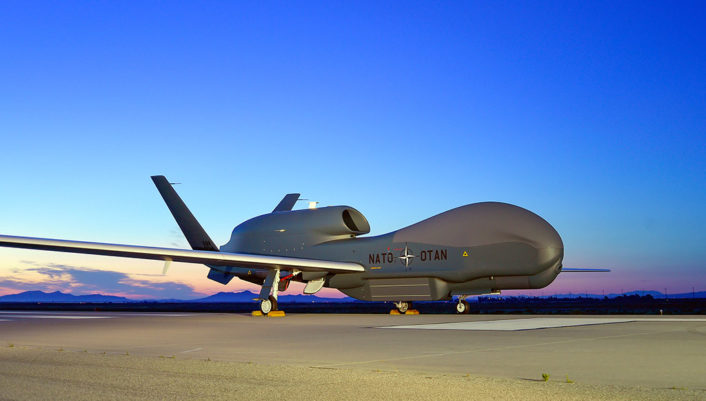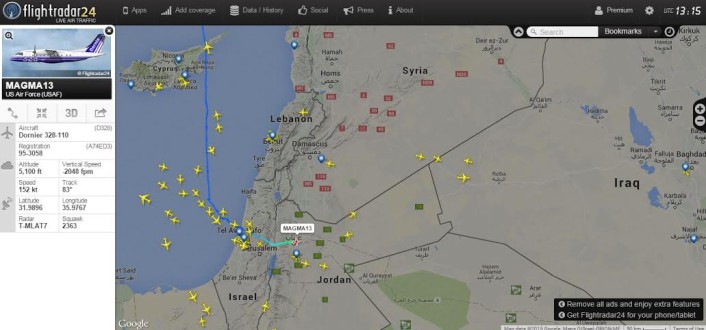NATO’s Alliance Ground Surveillance (AGS) system achieves important milestones as it progresses towards first operational flight.
NATO’s AGS is a cooperative defense project to give the Alliance the ability to monitor “what’s happening on the ground, at long range, over periods of time, around the clock, in any weather” and to provide a state-of-the-art Intelligence, Surveillance and Reconnaissance (ISR) capability to NATO.
A group of 15 nations is acquiring the AGS, an integrated systems consisting of an air segment, a ground segment and a support segment.
The air segment consists of five NATO RQ-4D aircraft and remotely piloted aircraft (RPA) flight control elements. The aircraft, is based on the Northrop Grumman Block 40 Global Hawk operated by the U.S. Air Force equipped with a state-of-the-art, multi-platform radar technology insertion programme (MP-RTIP) ground surveillance radar sensor, as well as an extensive suite of line-of-sight and beyond-line-of-sight, long-range, wideband data links.
The ground segment consists of a dedicated mission support facilities AGS MOB (Main Operating Base) in Sigonella, Italy, and a number of ground stations in mobile and transportable configurations, able to provide data-link connectivity, data-processing, exploitation capabilities and interfaces for interoperability.
According to NATO, “the ground segment will provide an interface between the AGS core system and a wide range of command, control, intelligence, surveillance and reconnaissance (C2ISR) systems. It will interconnect with multiple deployed and non-deployed operational users, as well as with reach-back facilities away from the surveillance area.”
While providing in-theatre situational awareness to commanders of deployed forces, the AGS system will be able to support a wide array of missions, going well beyond strategic or tactical reconnaissance: protection of ground troops and civilian populations; border control and maritime safety; anti-terror missions; crisis management and humanitarian assistance in natural disasters; as well as SAR support.

The story of the project until today is described in details by NATO in its website. Here’s an excerpt:
Originating from the Defence Planning Committee in 1992, the AGS programme was defined as a capability acquisition effort in 1995, when NATO Defence Ministers agreed that “the Alliance should pursue work on a minimum essential NATO-owned and -operated core capability supplemented by interoperable national assets.”
[…]
From the outset, the AGS capability was expected to be based on one or more types of ground surveillance assets either already existing or in development in NATO member countries, an approach that later also came to include proposed developmental systems based on American or European radars. However, all those approaches failed to obtain sufficient support by the Allies to allow their realisation. In 2001, the North Atlantic Council decided to revitalise AGS through a developmental programme available to all NATO countries and a corresponding cooperative radar development effort called the Transatlantic Cooperative AGS Radar (TCAR).
In 2004, NATO decided to move ahead with what was labelled as a mixed-fleet approach. The air segment was to include Airbus A321 manned aircraft and Global Hawk unmanned aerial vehicles (UAVs), both carrying versions of the TCAR radar, while the ground segment was to comprise an extensive set of fixed and deployable ground stations.
Due to declining European defence budgets, NATO decided in 2007 to discontinue the mixed-fleet approach and instead to move forward with a simplified AGS system where the air segment was based on the off-the-shelf Global Hawk Block 40 UAV and its associated MP-RTIP sensor.
[…]
In February 2009, the NATO Allies participating in the AGS programme started the process of signing the Programme Memorandum of Understanding (PMOU).
[…]
In September 2015, NATO AGS achieved important milestones such as the first live ground testing of NATO’s first RQ-4D aircraft and the activation of NATO AGS Force, meaning Allies formally agreed the configuration (number of staff, their rank structure, etc.) of the unit responsible for operating the AGS NATO RQ-4D remotely piloted aircraft from Sigonella Air Base.
Between September and December 2015, other important milestones were achieved:
- Mobile General Ground Station (MGGS) and Transportable General Ground Station (TGGS) roll-outs took place;
The first test flight of NATO’s first RQ-4D occurred in Palmdale, California; and
- AGS successfully participated in exercise Trident Juncture 2015 from the NATO AGS Capability Testbed (NACT) in the Netherlands.
From 2016 to 2019, a number of test flights took place in order to further develop and test AGS capabilities. These included the first flight remotely controlled from the AGS Main Operating Base in Sigonella at the end of 2017.
Throughout 2018 and 2019, AGS temporary infrastructure at the Main Operating Base has been put in place. The construction of permanent facilities for AGS began on the site and is expected to be completed in 2021.
Training of AGS pilots, Joint ISR analysts, sensor operators and maintainers has also been initiated at the Main Operating Base, marking the first steps for the creation of a Premier NATO Training Centre in Sigonella. Once fully operational, the centre will host 22 training instructors including mission crew and pilot trainers, working with a simulation capability that will be able to take on around 80 trainees per year.
The first AGS NATO RQ-4D aircraft, to be followed by four additional aircraft, is expected to fly from the United States to its new permanent home in Sigonella, Italy in 2019. Following arrival, a system-level performance verification phase will begin in order to ensure full compliance of the system with NATO requirements.
With an official ceremony held in Rome last week, the AGS system made some important steps towards its first operational flight from Sigonella. In fact, during the ceremony Brigadier General Volker Samanns, NAGSMA (NATO Ground Support Management Agency) was handed over the Military Type Certification (MTC), the mandatory airworthiness certification issued to the system by the Italy’s DAAA, the Directorate of Aeronautical Armaments and for Airworthiness.
“With the MTC, an important milestone was reached, achieved through an innovative path characterized by a fruitful cooperation with the US authorities and in particular with the U.S. Air Force”, Director of the Directorate of Aeronautical Armaments and Airworthiness, Chief Inspector General Basilio Di Martino said at the end of the ceremony.
Another important achievement was the assigment of an official ICAO radio callsign to the AGS aircraft: “MAGMA”. Indeed, even though the aircraft is remotely piloted, it uses standard U/VHF radios to talk to the civil and military ATC agencies as any other manned plane. The assignment of the callsign took place at the end of a complex process initiated by the Italian Air Force, which involved the ENAC (Italy’s National Civil Aviation Authority), and led to the attribution by the International Civil Aviation Organization of the radio c/s that will be used in flight by the aircraft.
During the ceremony, Brig. General Fabio Sardone, Head of General Office for Military Air Circulation, underlined the key role played in the AGS program by Italy which “has actively participated in the NATO working group, favoring the integration of the remote piloted aircraft in the air space and actively working for the assignment of the radio callsign by ICAO”.
Noteworthy, MAGMA is a pretty famous radio callsign among airband listeners and aviation enthusiasts. Indeed, it is used by C-146A Wolfhounds belonging to the 524th Special Operations Squadron of the Air Force Special Operations Command that, using callsign MAGMA, can be frequently tracked online as they fly between Stuttgard and airports in the Mediterranean and the Middle East.










